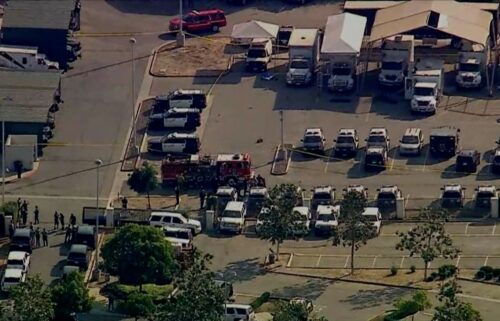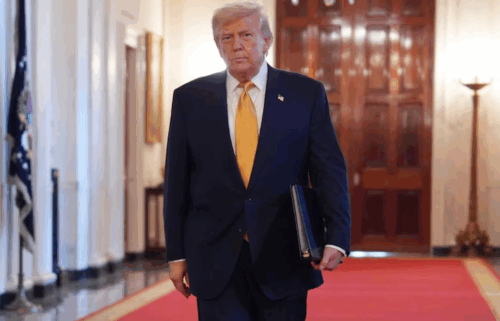Ghost hunters say this is their biggest fear. And it has nothing to do with ghosts

David Schrader is creeping through the darkened hallways of the most-haunted house in America, looking for trouble.
It’s well past midnight, and his paranormal team has been summoned to the 19th-century brick house in San Diego because people say a malevolent spirit dubbed “Yankee Jim” has taken up residence. They report hearing his footsteps clanking down the stairs at night, strange mists floating through rooms, cold spots and the sensation of being watched.
As Schrader feels his way through the darkness, he senses that something is stalking him. So does Cindy Kaza, a psychic on his team who whispers to him, “I don’t want to be here.”
“If you’re trying to influence Cindy you need to back off,” Schrader, a burly man with a shaved head and a goatee, announces as he scans the room. “You do not have power or authority over her.”
Then someone, or something, slams into the 6-foot, 280-pound Schrader. He’s knocked to his knees as if he’s been sucker punched — and no one has touched him.
“Something just shoved me straight on,” he says, a look of bewilderment crossing his face. “That’s nuts.”
What’s scarier than ghosts?
It’s just another night at the office for Schrader, one of the nation’s top paranormal investigators. For the past 13 years, he has tangled with dark entities, listened to disembodied voices and visited many of the world’s most haunted places.
That haunted house smackdown was filmed for Schrader’s new show, “The Holzer Files.” In the Travel Channel series, he and a team of paranormal experts reinvestigate the “secret files” of Hans Holzer, one of America’s first ghost hunters.
Every day is Halloween for people like Schrader, one of a new wave of celebrity paranormal investigators who have inspired countless people to form amateur ghost-hunting teams across America.
People routinely ask him about scary stories. But when CNN asked Schrader and other famous ghost hunters to share their biggest frights, none mentioned confronting entities such as “Yankee Jim.”
People spook them more than spirits, they all say. One of the biggest secrets of the paranormal field is that it is filled with all sorts of earthbound hazards that newbie investigators never contemplate: Mentally ill people who physically attack investigators during house calls; unscrupulous investigators who stage supernatural encounters; criminals robbing and beating ghost-hunting teams in abandoned buildings.
“The living are much more scary than anything paranormal I’ve come into contact with,” Schrader says.
And then there is another, little-known occupational hazard — the sheer terror of tedium. Nothing happens during most investigations. An estimated 80% of paranormal disturbances are ultimately attributed to things as mundane as bad housing construction, investigators say.
“There is something out there, and we don’t know what it is,” says Elaine Davison, an Oregon paranormal investigator. “But I will tell you that most of it is bad wiring.”
Why ghost hunters do what they do
So why do paranormal investigators persist despite the dangers?
The reasons vary. Many had childhood experiences that stoked their curiosity. Schrader’s grandmother used to visit him as a kid after she died.
Others mention similar experiences: A ghost kissed one investigator on her cheek as she feel asleep one night; another says they witnessed an exorcism, and another famous ghost hunter started seeing apparitions after visiting a healer.
Some also pursue this unique calling because they want proof of life beyond death. Others like the adrenalin rush. And virtually all say they’re providing a service. They help grieving families who often have tried everything else to heal. Sometimes, they say, they even help ghosts.
What ghosts want is often what humans want — acknowledgment that they matter, Schrader says.
He cites the story of a ghost who haunted a family until investigators discerned her identity. They hung a portrait of the dead woman in the house and the hauntings ceased, he says.
“A lot of these spirits have a story that needs to be told, and they had been forgotten,” Schrader says.
But paranormal investigators can’t discover those stories if they don’t take precautions.
To help protect ghost hunters — and the people who hire them — here are some safety tips from Davison and other leading paranormal investigators.
Tip 1: People are strange
Nothing seems to scare Jason Hawes. He helped launch the paranormal renaissance in 2004 with his seminal TV series, “Ghost Hunters.” The show featured some of the most chilling footage ever captured on camera: apparitions running through darkened corridors; household objects being moved by some unseen force; a cameraman who was so shaken after being attacked by some entity that he started to weep.
Hawes is back this year with a new series, “Ghost Nation.” In the show, his team tackles cases that have left local paranormal investigators stymied. Part of Hawes’ appeal is his gruff, everyman persona. He’s a plumber by day and goes into each case intent on disproving paranormal activity.
He started seeing apparitions after seeing a woman who practiced Reiki, an alternative form of healing.
He also says encounters with living people make his heart thump the loudest.
“I get scared by homeowners,” Hawes says. “You never know who is also on the other side of the door. I’m not scared of the dead. I’m scared of the living.”
Once an elderly woman invited Hawes and his team to inspect her home for ghosts. As they were chatting in the woman’s living room, she excused herself to go into her kitchen to make tea.
“Ten minutes later she comes out with a frying pan and thinks we’re intruders,” Hawes says.
On another occasion a man had invited Hawes’ team to inspect his home for a haunting. The man had moved out of the house, but it wasn’t abandoned — as Hawes and his team discovered one night.
“All of a sudden we walk into a back room where squatters are doing drugs,” Hawes says. “The homeowner didn’t even know they were there.”
Then there is another type of horror, that of a misplaced diagnosis. Paranormal investigators will sometimes encounter people who report seeing demons or hearing voices. But the afflicted person’s problem is mental, not paranormal, says Hawes, who keeps a psychologist on his team for such occasions.
“We’ve walked into homes where people are dealing with sexual abuse, all sorts of things,” he says. “You always have to be on guard.”
Tip 2: A ghost won’t kill you, but this will
There are other paranormal hazards that people never consider, says Davison, who has written a book, “An Investigators Guide to Paranormal Safety.” Davison says she became interested in the paranormal after a long-dead relative came to her on successive nights and kissed her on the cheek.
That experience didn’t scare her, but something else does: black mold, toxic dust and rodents carrying diseases. That’s what paranormal investigators often encounter while investigating old buildings and historic sites, she says.
Some contract illnesses or fare even worse. One investigator fell off of an icy roof because he was so preoccupied with setting up a camera. Another was electrocuted by a dangling wire, she says.
“Every year paranormal investigators get killed,” Davison says.
Schrader, host of “The Holzer Files,” says some teams don’t recognize the enormous risks that come from simply walking in the dark.
“I’ve been in paces where people have fallen off of the second floor because there is no railing,” he says.
Tip 3: Don’t play with Ouija boards
Other hazards can put a person’s soul — not just their body — at risk, some paranormal investigators say.
Consider this famous real-life story.
A young boy in Cottage City, Maryland, loses his beloved aunt. He finds a Ouija board in his home and attempts to communicate with her. Strange things start happening in his house, such as mysterious scratching sounds in the walls and objects being moved by some unknown source. Finally, the boy becomes possessed by a demon that can only be driven out by a team of exorcists led by a determined priest.
That story, first reported by a newspaper, became the basis for the 1973 movie, “The Exorcist.” It’s one reason some people say one should never play with a Ouija board.
“You’re asking something to enter you, and you’re opening yourself up to a world of trouble,” Hawes says. “You’re asking something to use you as a puppet. I would never open myself to it.”
Tip 4: Don’t taunt dead people
Here’s another paranormal no-no: challenging or otherwise provoking the spirits.
Some paranormal TV series feature hosts who insult unseen entities and challenge them to reveal themselves. It’s like playground taunts of “Yo mama” — meant to provoke a reaction.
Schrader says that was his mistake in the notorious Whaley House, the San Diego paranormal hotspot, when he challenged the entity who had spooked the psychic that accompanied him.
“It let me know I’m not in charge. It knocked me on my ass,” he says.
Davison also warns against provoking spirits.
“It’s mean, stupid and cruel,” she says. “You could be challenging someone who is a 98-year-old woman. Would you want someone to do that to your grandmother?”
Tip 5: Don’t be too proud to run
Still, there are some spirits who don’t merely want to be acknowledged. They want to torment you, paranormal investigators say.
If you run into one, their advice is simple:
Don’t be too proud to put on your running shoes.
“Run! Learn from the movies,” says Glynn Washington, host of the popular radio show and podcast “Spooked.” Washington says he witnessed an exorcism as a teenager and grew up in a family haunted by ghosts.
“Don’t think you’re going to be a hero. You’re not,” he says. “Wait until it’s over and after the spirit, the monster or the demon has left.”
Even the most intrepid paranormal investigators say they’ve taken such advice.
Davison and a team were once investigating a home in Lebanon, Oregon, where multiple killings had taken place. As they were tiptoeing through the house one night, they kept detecting a rancid odor that would come and go, she says.
A team member then turned on the “Spirit Box,” an electronic device that’s supposed to scan radio frequencies along with a unique synthetic noise that enables spirits to communicate in their own voices.
Davison says her team asked whatever presence was in the house to tell them what it wanted. They heard nothing. Then they replayed a transmission from the Spirit Box.
In it they heard a menacing voice replying to their question.
It growled: “Get out!”
“At that point,” Davison says, “we all said, ‘Thank you. We’re leaving.'”
She says she’s never figured out where that voice came from. And her team has never bothered to go back to find out.




